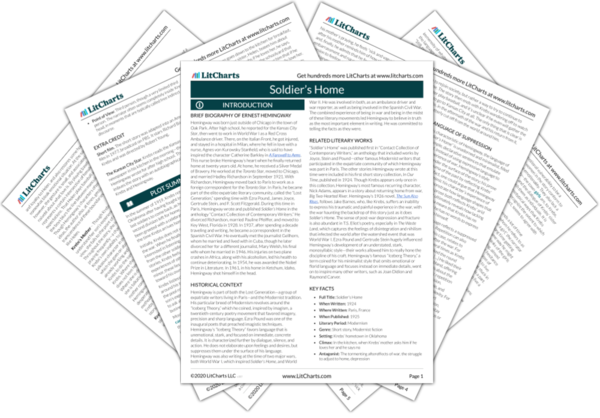War and Trauma
Hemingway’s “Soldier’s Home” tells the story of a young soldier named Krebs returning home after World War I. Though Hemingway does not explicitly narrate Krebs’ emotions, the story’s hard-boiled prose style represents Krebs’ suppressed psyche: after the war, Krebs sleeps late, can hardly muster the energy to talk to anyone, and wanders aimlessly around his home town. This disconnect between Krebs and the people around him—his family, other soldiers, and the girls he watches from…
read analysis of War and TraumaLanguage of Suppression
As is characteristic of Hemingway, the language of “Soldier’s Home” is unadorned and minimalist, filled with simple, declarative sentences that emulate Krebs’ state of mind. Instead of using expressive language to reveal the painful experience of war, Hemingway’s style suppresses that pain under the surface of the story; his prose implies the immense trauma of the past by reflecting Krebs’ inability to describe it. In fact, one could argue that Hemingway uses language not only…
read analysis of Language of SuppressionMen and Women
In much of his work, Hemingway’s characterization of men and women tends to conform to what a modern reader might describe as rigid, sexist gender expectations. “Soldier’s Home” is no exception. While Krebs’ inability to express his feelings can be chalked up to the trauma of war, it also represents a traditionally stoic masculinity that holds emotional vulnerability to be a weakness. In contrast, the women in the story conform to traditional ideas of feminine…
read analysis of Men and Women
Lies and Society
The idea of lying recurs several times throughout “Soldier’s Home,” and holds a central place in the story. While there are many hints that the trauma of war has profoundly impacted Krebs and that his apathy, disaffection, and loss of a sense of self upon returning home stems from PTSD, the story more explicitly locates Krebs’ issues as stemming from the fact that, upon returning home, “to be listened to at all [about his experiences…
read analysis of Lies and Society






